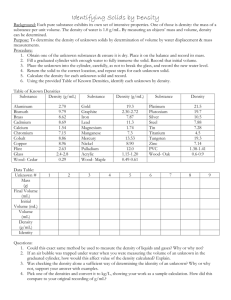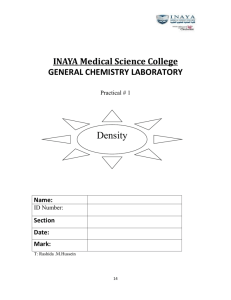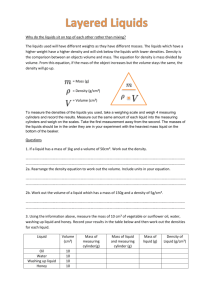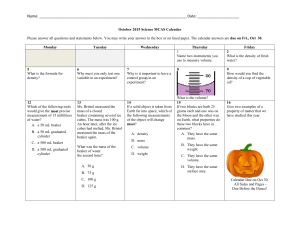General Chemistry I (FC, 09 - 10) Lab # 1: The Densities of Solids
advertisement
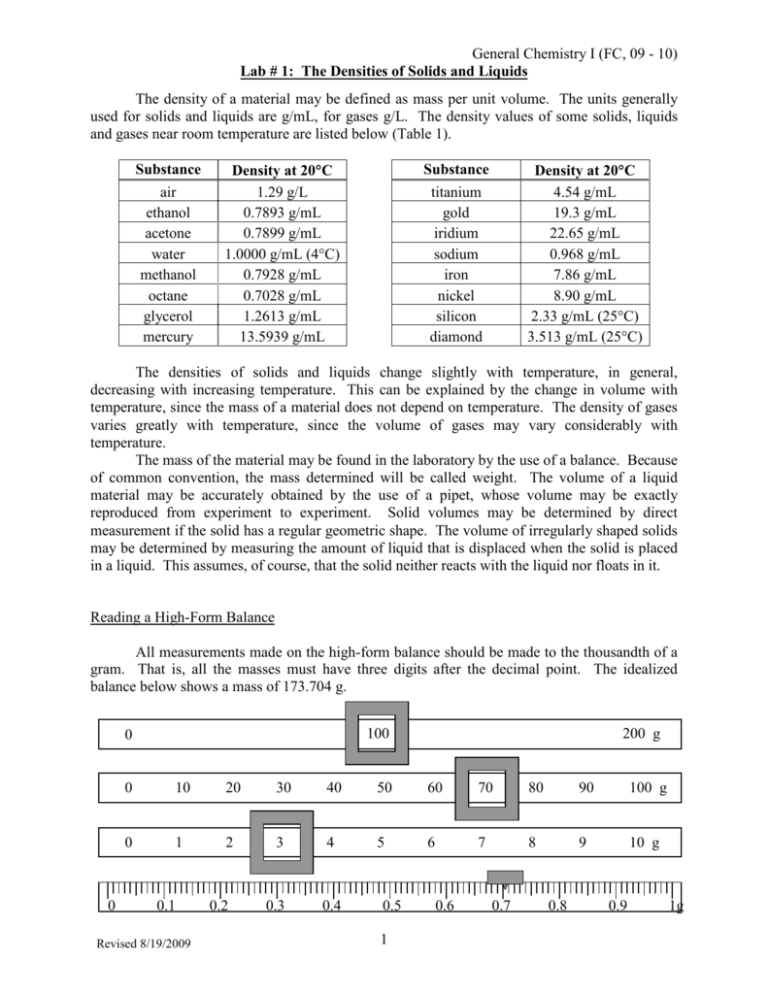
General Chemistry I (FC, 09 - 10) Lab # 1: The Densities of Solids and Liquids The density of a material may be defined as mass per unit volume. The units generally used for solids and liquids are g/mL, for gases g/L. The density values of some solids, liquids and gases near room temperature are listed below (Table 1). Substance air ethanol acetone water methanol octane glycerol mercury Substance Density at 20°C 1.29 g/L 0.7893 g/mL 0.7899 g/mL 1.0000 g/mL (4°C) 0.7928 g/mL 0.7028 g/mL 1.2613 g/mL 13.5939 g/mL Density at 20°C 4.54 g/mL 19.3 g/mL 22.65 g/mL 0.968 g/mL 7.86 g/mL 8.90 g/mL 2.33 g/mL (25°C) 3.513 g/mL (25°C) titanium gold iridium sodium iron nickel silicon diamond The densities of solids and liquids change slightly with temperature, in general, decreasing with increasing temperature. This can be explained by the change in volume with temperature, since the mass of a material does not depend on temperature. The density of gases varies greatly with temperature, since the volume of gases may vary considerably with temperature. The mass of the material may be found in the laboratory by the use of a balance. Because of common convention, the mass determined will be called weight. The volume of a liquid material may be accurately obtained by the use of a pipet, whose volume may be exactly reproduced from experiment to experiment. Solid volumes may be determined by direct measurement if the solid has a regular geometric shape. The volume of irregularly shaped solids may be determined by measuring the amount of liquid that is displaced when the solid is placed in a liquid. This assumes, of course, that the solid neither reacts with the liquid nor floats in it. Reading a High-Form Balance All measurements made on the high-form balance should be made to the thousandth of a gram. That is, all the masses must have three digits after the decimal point. The idealized balance below shows a mass of 173.704 g. 100 0 0 200 g 0 10 20 30 40 50 60 70 80 90 100 g 0 1 2 3 4 5 6 7 8 9 10 g 0.1 Revised 8/19/2009 0.2 0.3 0.4 0.5 1 0.6 0.7 0.8 0.9 1g General Chemistry I (FC, 09 - 10) Lab # 1: The Densities of Solids and Liquids Reading a Graduated Cylinder The 10 mL graduated cylinder you will use typically can be read to 0.02 mL. Each reading from it must therefore have two digits after the decimal point. The volume must be read from the bottom of the meniscus, shown in the picture below by the arrow. The idealized graduated cylinder below contains a volume of 7.72 mL. (If your graduated cylinder is different from the one pictured below, see the instructor.) 10 mL 9 8 bottom of the meniscus 7 6 5 4 3 2 1 Revised 8/19/2009 2 General Chemistry I (FC, 09 - 10) Lab # 1: The Densities of Solids and Liquids Table 2: Absolute Density of Water (g/mL) 0.2 0.3 0.4 0.5 0.6 Degrees 0.0 0.1 0.7 0.8 0.9 0 0.999841 847 854 860 866 872 878 884 889 895 1 900 905 909 914 918 923 927 930 934 938 2 941 944 947 950 953 955 958 960 962 964 3 965 967 968 969 970 971 972 972 973 973 4 973 973 973 972 972 972 970 969 968 966 5 965 6 941 963 961 959 957 955 952 950 947 944 938 935 931 927 924 920 916 911 907 7 902 898 893 888 883 877 872 866 861 855 8 849 843 837 830 824 817 810 803 796 789 9 781 774 766 758 751 742 734 726 717 709 10 700 691 682 673 664 654 645 635 625 615 11 605 595 585 574 564 553 542 531 520 509 12 498 486 475 463 451 439 427 415 402 390 13 377 364 352 339 326 312 299 285 272 258 14 244 230 216 202 188 173 159 144 129 114 15 099 084 069 054 038 023 007 *991 *975 *959 16 0.998943 926 910 893 877 860 843 826 809 792 17 774 757 739 722 704 686 668 650 632 613 18 593 576 558 539 520 501 482 463 444 424 19 405 385 365 345 325 305 285 265 244 224 20 203 183 162 141 120 099 073 056 035 013 21 0.997992 970 948 926 904 882 860 837 815 792 22 770 747 724 701 678 655 632 608 585 561 23 538 514 490 466 442 418 394 369 345 320 24 296 271 246 221 196 171 146 120 095 069 25 044 018 *992 *967 *941 *914 *888 *862 *836 *809 26 0.996783 756 729 703 676 649 621 594 567 540 27 512 485 457 429 401 373 345 317 289 261 28 232 204 175 147 118 089 060 031 002 *973 29 0.995944 914 885 855 826 796 766 736 706 676 30 646 616 586 555 525 494 464 433 402 371 Each value from this table is good to six significant figures. For example, the density of water at 17.7°C is 0.998650 g/mL. The last 3 digits come from the 650 in the box at 17.7 and the first 3 digits come from the 0.998 in the box at 16.0 (the closest value before the desired temperature that shows all 6 digits). Revised 8/19/2009 3 General Chemistry I (FC, 09 - 10) Lab # 1: The Densities of Solids and Liquids EXPERIME2TAL PROCEDURE: Density of Liquids: (See figure below) Weigh a small, clean beaker and record the weight (Mass 1). Stop and get the instructor to check your measurement. Obtain an unknown liquid and record the unknown number. Pipet 10.00 mL of the unknown liquid into the beaker. Weigh the liquid and the beaker (Mass 2). Pipet another 10.00 mL of liquid into the beaker and weigh (Mass 3). Pipet a third 10.00 sample of liquid into the beaker and weigh (Mass 4). Return the liquid to the bottle. Rinse the beaker and reweigh. Rinse the pipet several times with distilled water. As with the unknown liquid, pipet three 10.00 mL aliquots of distilled water into the beaker, weighing after each 10.00 mL portion. Measure the temperature of the water to the nearest 0.1°C. Mass 4 = mass beaker + 30 mL liquid Mass 3 = mass beaker + 20 mL liquid Mass 2 = mass beaker + 10 mL liquid Mass 1 = mass beaker (empty) Density of a Solid: Obtain an unknown metal sample and record the unknown number. Clean and dry a 10 mL graduated cylinder. Add approximately 5 mL of distilled water to the cylinder and record the water level to 0.02 mL (2 digits after the decimal point). Record the mass (to 3 digits after the decimal point) of the water and the cylinder. Stop and get the instructor to check your measurements. Carefully, to avoid splattering, add metal to the water until one-third of the sample is used or the level of the water reaches about 9.5 mL, whichever comes first. The metal must be completely submerged and the water level must not exceed 10 mL. Record the new volume of water and metal and the new mass of water, metal and graduated cylinder. Carefully pour the water out of the graduated cylinder, making sure you do not pour any metal down the drain. Pour the wet metal onto a paper towel. Repeat the volume and mass measurements with the metal until you have three sets. Return all the wet metal to the original bottle. Revised 8/19/2009 4 NAME ___________________________________ General Chemistry I (FC, 09 - 10) Lab #1: The Densities of Solids and Liquids DATA A2D CALCULATIO2S Density of Liquids Trial 1 Trial 2 Trial 3 Unknown # of liquid Mass of beaker (g) (Mass 1) Mass of beaker & liquid (g) (Mass 2) (Mass 3) (Mass 4) (Mass 2 – Mass 1) (Mass 3 – Mass 2) (Mass 4 – Mass 3) Mass of 10.00 mL of liquid (g) Density of liquid (g/mL) Average density of liquid Mass of beaker (g) (Mass 1w) Mass of beaker & water (g) (Mass 2w) (Mass 3w) (Mass 4w) (Mass 2w – Mass 1w) (Mass 3w – Mass 2w) (Mass 4w – Mass 3w) Mass of 10.00 mL of water (g) Density of water (g/mL) Average density of water Temperature of water (°C) Density of water from Table 2 Revised 8/19/2009 5 NAME ___________________________________ General Chemistry I (FC, 09 - 10) Lab #1: The Densities of Solids and Liquids What is the percent error of the density of the water? % error = actual experimental x 100 actual Density of a Solid Unknown # ______________ Trial 1 Trial 2 Trial 3 Volume of water (mL) Volume of water & metal (mL) Volume of metal (mL) Mass of water & cylinder (g) Mass of water, cylinder & metal (g) Mass of metal (g) Density of metal (g/mL) Average density (g/mL) Instructor’s Initials ______________ Revised 8/19/2009 6 NAME ___________________________________ General Chemistry I (FC, 09 - 10) Lab #1: The Densities of Solids and Liquids The Electronic Balance There are several ways to use the electronic balances to weigh out materials. You will try three different methods. The last two make use of the tare feature of the balances and are the methods with which you should become most familiar. When given an amount of a material to be measured, unless there are specific directions as to a minimum or maximum amount, you can generally differ by about 5% in either direction. For example, when you are asked to weigh 2 g of a substance, do not waste your time trying to get 2.000 g. Five percent of 2 g is 0.1 g so weigh out between 1.9 g and 2.1 g. Make sure that you record ALL the digits that the balance gives you. (For less than 60 g on the balance pan, you should have three digits after the decimal point. For more than 60 g, you will only have two.) A. DIRECT WEIGHING WITHOUT USING THE TARE BUTTON Use either a plastic weighing boat or a piece of weighing paper. 1. Weigh the weighing boat or paper. Record the mass. _________________ 2. Add 2 g of the salt to the boat or paper. Record the mass. _________________ 3. Subtract the mass of the boat from the mass of the salt and boat. _________________ B. DIRECT WEIGHING USING THE TARE BUTTON 1. Weigh the weighing boat or paper. Hit the TARE button. The mass will be set to zero g. 2. Add 2 g of the salt to the boat or paper. Record the mass. _________________ C. INDIRECT WEIGHING USING THE TARE BUTTON 1. Weigh the bottle of salt. Hit the TARE button. 2. Pour 2 g of the salt out of the bottle. In this case, pour out a small amount in the manner demonstrated by the instructor. Place the bottle back on the balance pan. The amount you have poured out will be the negative of the mass shown. Continue pouring until you have reached 2 g. Record the mass. _________________ Before returning the salt to the bottle, show the instructor at least one of your weighed samples. Revised 8/19/2009 7 NAME ___________________________________ General Chemistry I (FC, 09 - 10) Lab #1: The Densities of Solids and Liquids PRESTUDY 1. (3) Using the Absolute Density of Water table, answer the following questions. a. Does the density of water increase or decrease as the temperature decreases from 2.0 to 1.0°C? b. Look up the densities of water at each of the following temperatures. 21.0°C ______________________ 17.3°C ______________________ 2. (4) a. An empty graduated cylinder weighs 25.489 g. When the cylinder contains 45.3 mL of an unknown liquid, it weighs 57.847 g. What is the density of the unknown liquid? Show your work. b. The unknown liquid from part a is octane; calculate the percent error of the density. Show theoretical value experimental value x 100 your work. % error = theoretical value 3. (3) A graduated cylinder is filled with 24.5 mL of water. After placing an unknown solid in the graduated cylinder, the water level rises to 31.9 mL. The mass of the cylinder and water before the solid was added was 49.989 g and after adding the solid, the mass is 119.993 g. Calculate the density of the solid. Show your work. Revised 8/19/2009 8



